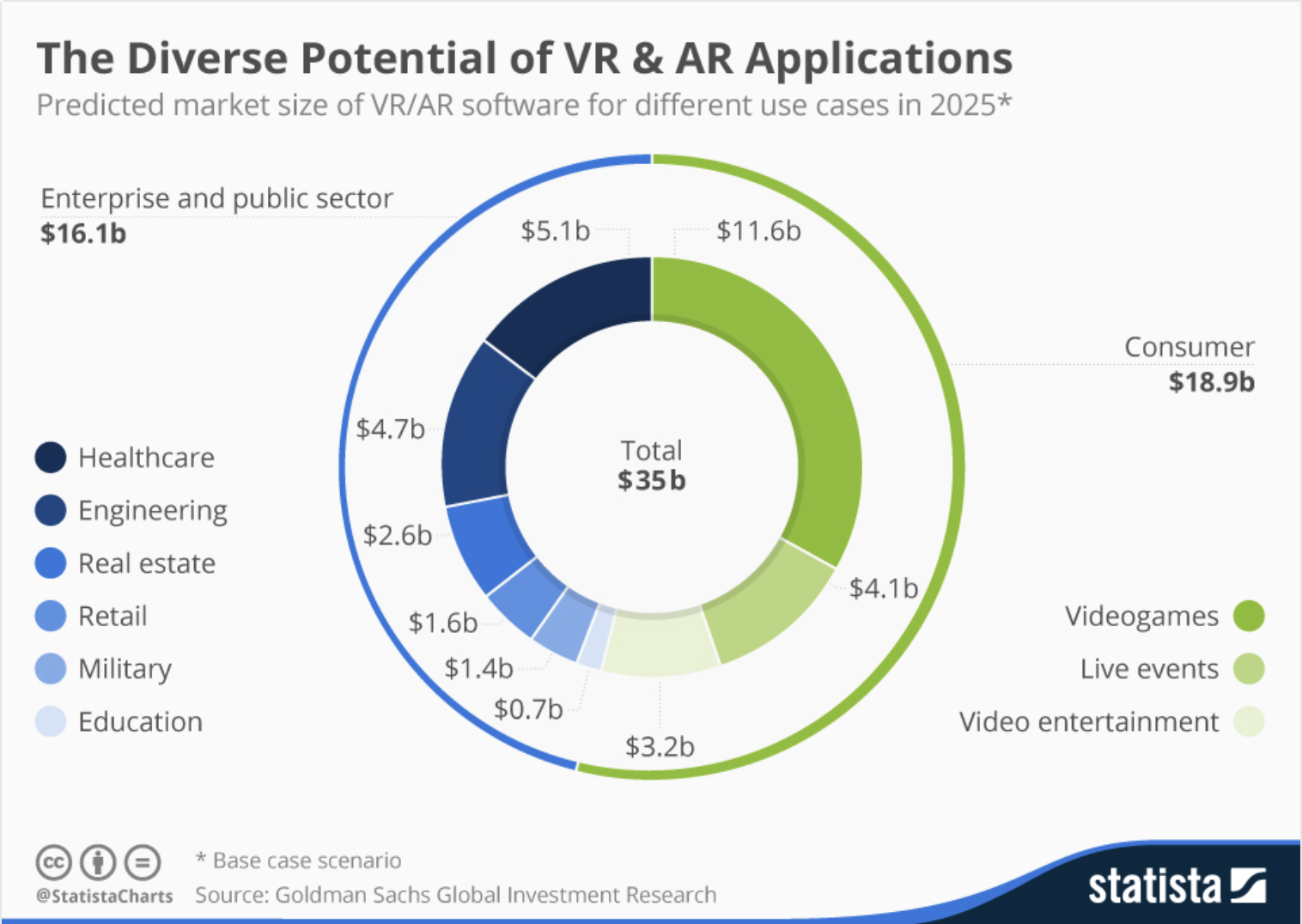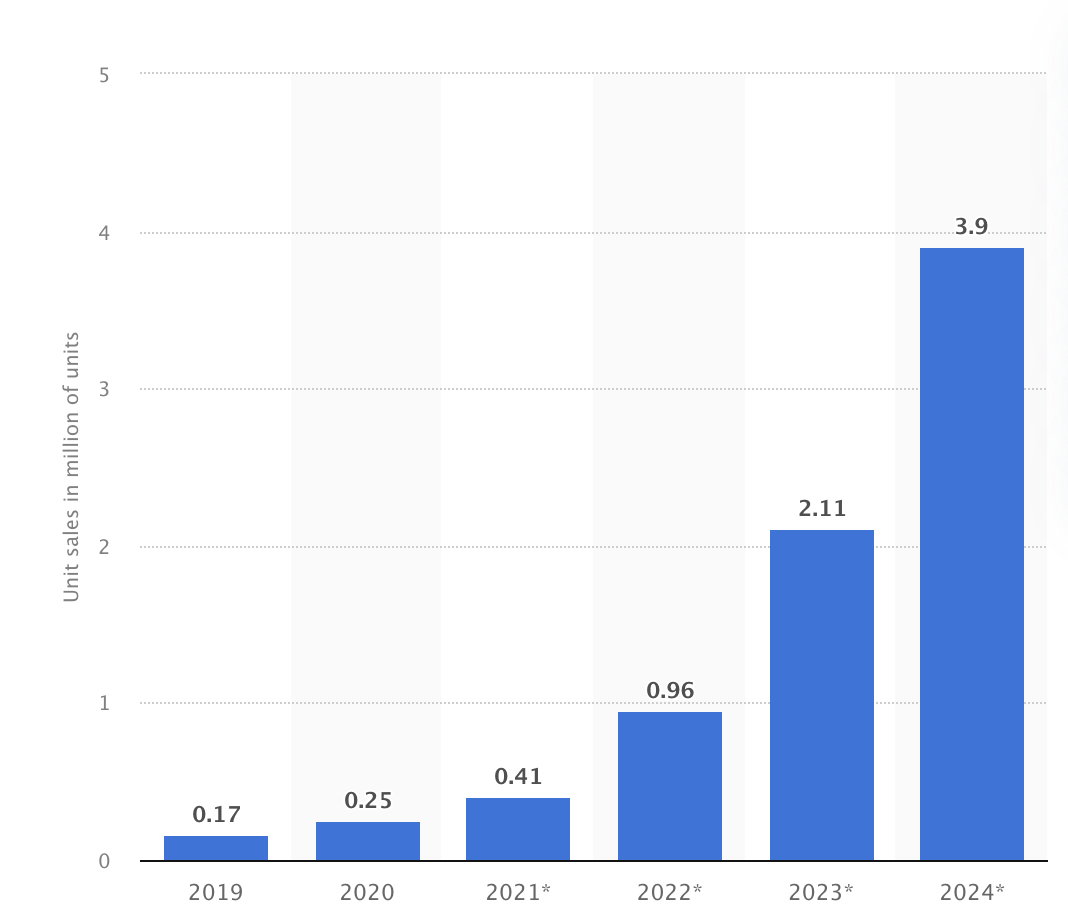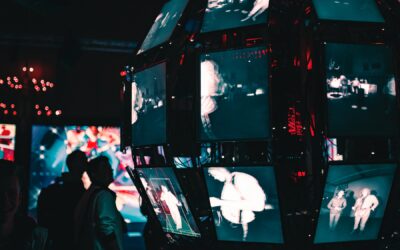The last decade alone in technology has been a force to be reckoned with and the way in which new technologies are being used is ensuring that innovative methods are being applied to a range of sectors. From finance to construction to manufacturing, technology can help streamline and refine industry processes.
Although a lot of technological advances and virtual technology were being used before the global pandemic, Covid-19 has become a forceful catalyst for the way that many people work and created a space for innovative work practices. Being a company that can offer working from home solutions has now become an expectation for potential employees and workers. Augmented Reality in particular has become a relied upon advance that can aid success in a safe and secure way and is now becoming a way that people and workers are upskilling themselves.

(Image Source: Statista)
What is augmented reality?
Augmented Reality is a way in which the real world and virtual world are combined. Through computer generation, a virtual image is augmented onto the real world. It is a way to superimpose digital imagery and concepts onto the environment around you. Objects can be enhanced and can often be paired with other sensory modalities using augmented reality.
The overlay of virtual and empirical allows a user of augmented reality to experience a seamless immersion of mixed reality in a way that can aid their imagination.
Augmented reality often gets confused with virtual reality, but differs from this as virtual reality is a completely immersed digital world rather than a pairing of both real and virtual. Augmented reality can use elements of the virtual world, rather than becoming an entire immersion away from the real world as virtual reality would.
There is a variation of tools that can be used to house an augmented reality and implement it into everyday use and activity and some of these are new to the market and some have been in use for longer amongst certain communities.
Augmented reality hardware comes in the form of processors and sensory displays and can even be used by some modern smartphones, tablets, and computers. Using a camera, games such as PokemonGo have thrived because of the pairing of the real and virtual. The aim of the game was to find virtual Pokemons on your hardware device (the virtual element) within a real environment and using GPS of the area around you. This is a great example of Augmented Reality and using it within the gaming world is a community in which it has really thrived, but augmented reality isn’t a tool that is simply reserved for the gaming world.
Another piece of hardware is the use of headgear or eyeglasses. Wearing these glasses is an easy way to have an augmented reality display. Versions of eyeglasses can include cameras and head mounts which can allow the user to see augmented reality elements through the lenses. Although eyeglasses in the commercial sense are still in development there are still some on the market that people can use for everyday tasks, such as navigation and can even be set up when working from home and using augmented reality in everyday space.
Alongside being used from home within traditional office roles, the scope of possibilities with augmented reality can also be used within the manufacturing world and the pandemic has accelerated the development of augmented reality techniques within this sector as the restrictions meant that many people could not attend work.
Remote Assistance Solutions
Remote assistance solutions have relied upon implementation when it comes to remote working within manufacturing. It means that a customer can get online advice and guidance from anywhere in the world and using augmented reality is a method in which more complex requests and assistance are needed. Receiving expert help and assistance on a piece of equipment or usage can be dictated using augmented reality. An operator can send remote images of what an operator is viewing and this would give an expert the tools and information to suggest an immediate solution to a technical problem and most importantly is conveyed in real-time. This particular remote assistance solution can be offered by using smart glasses and ensures hands-free manoeuvring and a streamlined process. With the ability to access technical equipment from anywhere using augmented reality, the number of issues that can be solved in a day will be significantly increased because of this streamlined process.
This remote solution within manufacturing will allow sales teams and representatives to present images and prototypes of new products and technologies to customers in an accurate and interactive way. It’ll be like seeing products in-store, but from the comfort of your own home and in real-time customer service. Many businesses and employees will now have established their own comfortable working from home spaces, so this method will work in a parallel way to new styles of working.
3D Presentation Methods
Just as remote assistance solutions will be able to assist with technical difficulties in a remote fashion, 3D presentation methods will also ensure seamless marketing within the manufacturing industry. Augmented reality can facilitate replicas of products and new innovations using holograms. This, in turn, will allow animated elements, including images, video and text be used to present certain methodologies and in some cases prototypes without using the empirical materials to build one in the initial stages of manufacturing processes.
The use of 3D presentation methods could also be used in a factory setting in the form of image comparison. The bare bones of image comparison are that quality images can be used to compare products between manufacturer and supplier. These high-resolution images in an augmented reality form can be overlaid and create a visual representation of an existing building and allow for future planning. As a result of this, the decisions based on the factory image comparison would reduce time and cost based on the resolution of any rebuilding being brought to light before any physical action is taken. The augmented reality within this capacity is still very much developing and growing but has been forecast to achieve significant sales increases within manufacturing itself. There have been scenarios and situations that have allowed 3D presentations methods to flourish in circumstances that they may never have been used in before and gives further insight into the way augmented reality will be used in a more common way.
Factory Planning
Paired with the use of 3D presentation methods, factory planning will most certainly be streamlined with the use of augmented reality. By using digital planning data, designs can be orchestrated on existing factory buildings, and with the use of smart hardware, this type of augmented reality working will be more accessible to the sectors involved within manufacturing planning. As the graph below shows the predicted sales of augmented reality glasses units are set to increase by over double within the next 5 years. The predicted increase could mean that manufacturing processes will be much sleeker as the factories, buildings, and units that are being planned will be able to factor in specific requirements by using augmented reality.

(Image Source: Statista)
With regards to machinery and equipment, augmented reality will assist in factory planning even further by ensuring that the manufacturing floor itself is a safe space. With alerts to equipment defects and replacements, the assembly of the machines, will in turn result in more customer satisfaction because if the
Dynamic Augmentation
The use of GPS and orientation sensors can be used within augmented reality as a way to provide orientation. The use of location coordinates within augmented reality is necessary for the responsive nature of using augmented reality. This can be referred to as dynamic augmentation. By using a relative placement over a reference mark, more advanced algorithms can be used within manufacturing and therefore be more accurately used. For example, with factory planning, the coordinates of an existing building will be used to accurately show how other features can be placed on top of it with the use of dynamic augmentation.
As dynamic augmentation is used as a responsive digital method, it can very much pick up the faces and body movements of people. It can create a reference point, even through various facial expressions and still get the right degree of augmentation. This is a powerful and useful tool within the world of manufacturing as worker’s movements can be factored into the repertoire of things that augmented reality can be used for. As augmented reality devices and dynamic augmentation can accurately reference a body, even with safety gear on, this technology can be utilised to identify unsafe working conditions in a manufacturing space. By layering digital information about a certain task, potential risks and hazards could be identified for each personal worker before they even have a chance to happen. Manufacturers can use augmented reality to assess worker temperatures, the operating status of machinery, and even co-worker location in particularly large working spaces. A worker could potentially assess a piece of equipment and what protection is needed to handle it without physically endangering themselves, for example checking if a piece of machinery is too hot and unsafe to handle with bare hands. The use of augmented reality and dynamic augmentation could also be used to assess the conditions of the machinery itself. Is it on the verge of breaking down or becoming unusable?
Employee Training
When it comes to manufacturing equipment, safety ought to be a top prerogative, and augmented reality can aid the reduction in accidents and train new workers and employees. With the most suited augmented reality tools even the most inexperienced employees can be trained, informed, and taught how to protect themselves. Even when in a remote setting, manufacturing workers can be encouraged to participate in work from home training and could even become a cost-effective strategy to manage a manufacturing business.
Technical training with equipment and learning spaces, coupled with large manufacturing business needs is quite a costly affair. With the use of augmented reality, the use of complex machinery, and dangerous equipment, training will be streamlined and made into a more effective and more accessible tool for learning and teaching. Workers and new employees will be able to use augmented reality to check into a motherboard and connected system that would inform them where products and the tools they need are and provide the necessary job information. A logistics team could scan these products and have fast turnaround times for customers and ensure delivery to the correct and proper location by using an augmented reality system.
By using augmented reality, a maintenance team and crew would accurately be informed about exactly what equipment and hardware need servicing and in turn, would aid the manufacturers themselves and prevent any workplace danger before it has a chance to happen. By using an augmented reality system, the operation times alongside the date of the last service will be a pure indication of probable site failures within the factory and again contributing to the welfare of the employees. The speculations that often run parallel with maintenance teams would be removed and would secure quicker response times and faster turnaround time when it comes to repairing machinery and equipment.
Streamlined Team Communication
Just as augmented reality devices can be used to streamline employee training and welfare, they can be a big contributor to the way that manufacturing teams communicate with each other. By augmenting tasks, they not only could become simplified but would increase the effective communication across departments and teams within manufacturing. A company board member or executive could see a digital prototype and oversee an actual product design in real-time without having to go to a manufacturing base every single time they wanted to do this. This could also work the other way around, if a manufacturing team needed a sign-off or approval on a product, the turnaround could be within a day, even when participating parties are overseas. This use of augmented reality would encourage communication and could offer insights and communication in a manner that would normally be reliant on a lot of back and forth communications. Augmented reality will ensure real-time communication, without compromising the integrity of a product or team member.
Knowledge Transfer and Asset Identification
The use of augmented reality to help workers and employees upskill and become contributing to the manufacturing industry is only part of the process. Asset identification is a way for technicians and engineers to find assets quickly and efficiently. It can mean identifying one device out of thousands and accelerating how quickly a job is done. As a result of this efficiency, workers can have more guided ways of working and free up time and productivity for other tasks.
Knowledge Transfer within manufacturing and industry, in general, shows great promise when it comes to augmented reality. As there has been a decline in skilled experts and workers when it comes to manufacturing, augmented reality creates a demanded accessibility to learning from these experts, no matter where they are in the world.

(Image Source: Statista)
With pandemic restrictions and the general decline in skilled workers, knowledge transfer is a way in which a skill set can be utilised even when the worker themselves may not be able to get on site. With augmented reality technology, industry workers can collaborate with others and share their knowledge and expertise across the board. The tools, such as dynamic augmentation and general digital add ons can be used to ensure that a safe and secure job is conducted and may even encourage more people to join the manufacturing workforce.
The software available within the augmented reality world can provide visual cues to trainees and allow them to follow the advice of experts. The guided training still has the bespoke nature of being taught by manufacturing industry professionals without them having to physically be there.
Product Development
Within manufacturing, the development and resource-heavy process of products can not only cost a lot of money but also take a lot of time. With augmented reality streamlining communication and training, it can also do the same for the product itself. Using augmented reality devices the time-consuming nature of product development can be significantly reduced. As the expert opinion and real-time training is a result of switching to augmented reality methods, the snowball effect of doing so will ensure quicker product innovation and turnaround.
Companies such as Airbus have already implemented mixed reality applications and augmented reality as a way to give workers access to 3D models of aircraft parts and the blueprint of it in its entirety. As a result of this, the checking and back and forth communications were significantly reduced, taking the inspection time from three weeks down to just three days. If methods like these were applied across the manufacturing sector as an entirety, the product turnaround and speed of new products coming to market would rocket. From the planning stage to the checking stage, to the manufacturing itself, the turnaround would boost the productivity and efficiency of manufacturers and their workforce.
In addition to the development of the product itself, the quality control of the materials would be completely automated and more accurate. Although the use of trained personnel to operate the augmented reality tools will still be required, the time it would take to manually check these will be speed up and the training needed to run the augmented reality hardware will ensure that there are still job opportunities within the industry.
Augmented Reality Implementation
The benefits of augmented reality within manufacturing are seemingly endless and the scope of this type of technology will most certainly be seen outside of the gamers realm, but the implementation of this technology may be slightly more complicated. As outlined previously, augmented reality often gets confused with virtual reality, which is considered simpler to implement as it is a completely digital and virtual space with no adaptations needed for the real world. With augmented reality taking into account the GPS and equipment features to be able to combine the real and digital will be subjective to each working space and set of systems, so the initial implementation will be a lengthy process. The virtual overlay elements will have to go through rigorous testing to ensure that it does actually streamline the manufacturing processes and team communications. Although in the long run using the augmented reality technology will save time and cost, the set-up will require training and dedication from the teams who will be using it will have to be concrete and secure.
The implementation of augmented reality will allow information to be collected about the environment in which products are being manufactured, this will then be fed to the workers and team to establish a streamlined process. The upskilling of staff that will come with augmented reality implementation will ensure that workers acquire a more updated skill set in alignment and in turn make them an asset in a competitive industry market. More jobs will be automated and manufacturing will have to ensure that the transition into this way of working has employee welfare at the forefront and this will be invested back into the business in the form of a more productive and skilled workforce. There needs to be a level of skill and familiarity when it comes to augmented reality implementation, so ensuring that you have the correct customised equipment and hardware is key if you want augmented reality to be on your side.
It is no secret that the implementation of augmented reality hardware and software will be a big change, but to be accelerated as a business model because of it, will change the nature of what a manufacturing business can offer in the long run. Faster production times, smoother customer service, and a highly-skilled workforce are only a few of the positives that will come from augmented reality in the manufacturing industry.








